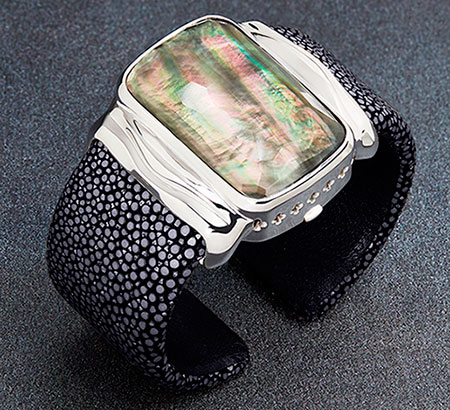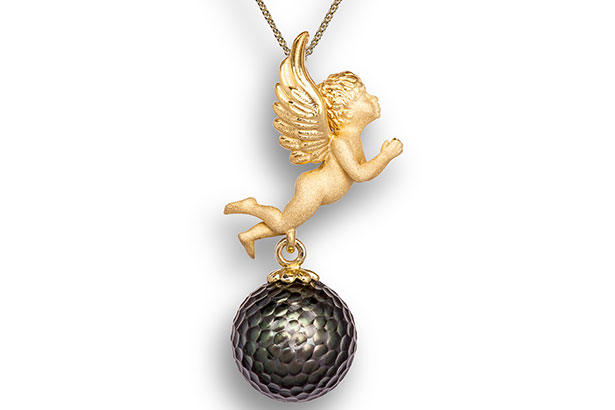The how and why behind ‘smart’ jewelry
By Joseph Dobrian
The how and why behind ‘smart’ jewelry
By Joseph Dobrian
The how and why behind ‘smart’ jewelry
By Joseph Dobrian

This black stingray bracelet with a mother-of-pearl doublet is the from Cuff line of “smart” jewelry being distributed by Richline Group. The wearer downloads an app to their iPhone or Android device and the cuff emits a single, or sequence of, buzzes that indicate a certain type of communication is coming into their smartphone, e.g., a text, a phone call, a notification that their Uber car has arrived. The bracelet also has a button the wearer can press to send their coordinates to family and friends in the event of an emergency. Pricing was not available as of press time.

The 14-karat yellow gold angel in Galatea’s “Angel Dream Keeper” pendant will hold a recorded message, images or video that can be heard or seen when tapped against a smartphone. The angel is suspended on an 18-inch chain with a carved Tahitian “Momento” pearl.

“Dive Bar” is the name Ringly gave to this particular piece, which has tourmalated quartz and a rhodium-plated band ($195 retail). Working with an app that’s downloaded to the wearer’s smartphone, the rings buzz or light up when the wearer receives notifications on their phone.
Eric Schmidt, chairman of Google, recently predicted that “the Internet will disappear.” By that, he meant that before long we won’t even notice the Internet because we’ll have so much of its technology on our persons at all times that it’ll become a matter of course.
“There will be... so many devices, sensors, things you are wearing, things that you are interacting with that you won’t even sense it,” he said at the conclusion of the World Economic Forum held in January in Davos, Switzerland, commentary that quickly found its way onto news web sites worldwide. “It will be part of your presence all the time.”
Much of this wearable technology retailers may be pleased, or not so pleased, to know is expected to come in the form of jewelry. The recent Consumer Electronics Show, held in January in Las Vegas, revealed just some of the high-tech jewelry on the market, and gave insight into which pieces might be feasible for jewelers to sell in their stores.
According to Richline Group’s chief marketing officer, Mark Hanna, the Tamarac, Fla.-based jewelry marketing and manufacturing company will be promoting Cuff’s line of “smart” jewelry, which includes bracelets, pendants, necklaces and key chains that incorporate the CuffLinc alert system, as well as Omate’s TrueSmart, along with other high-tech watches.
“The consumer will be ceding more and more disposable income to technology,” Hanna says. “The smartwatches we see now are almost all for men--the battery and chip size mandates this--but we want to create beautiful fine jewelry with relevant technology for women.” A number of different functionalities are available right now: notification systems relating to fitness, safety and medical alerts as well as message screens and phone notifications that let the wearer keep in touch with the world on a visible screen through a watch or a pendant.
“Scale is still an issue because of the size of the technology, but we have some pieces where you’d never know we had to put anything in there; we didn’t have to compromise the design of the jewelry,” he says. “Almost all of this technology now depends on proximity to your smartphone, but it doesn't have to be that way. It could just rely on Bluetooth.”
Notification/safety software is a critical part of the wearable technology mix, Hanna says.
A jewelry item could be programmed, for instance, to send notifications to a relative, the police and/or a neighbor in an emergency. And many of these products are designed to hit an affordable price point--Hanna says the items Richline is promoting mainly are in the $100 to $500 range, and an Omate watch made of silicone composite will retail at $99.
Some jewelers, though, are skipping right over the affordable to offer wearable technology with a big price tag attached. At Mervis Diamond Importers in Tysons Corner, Va., Vice President Jonathan Mervis reveals that the company is producing a limited-edition, diamond-encrusted version of the Apple Watch, with a tentative base price of $30,000.
“We’ll offer as many as people want,” he says. “We’ll customize; the point is to offer a unique piece. The base model will have a total weight of 15.14 carats. It’s a heavy piece, certainly over-the-top. Wearable technology is a whole new category that more people will jump into, and we want to be a leader.”
On a more sentimental note, Galatea, a San Dimas, Calif.-based carved pearl specialist, is offering the “Momento” collection, which employs near-field communication (NFC) technology to implant audio and video capabilities into a pearl. Chi Huynh, founder of Galatea, explains that a chip embedded into the stones can carry a voice message that will play when the pearl is tapped against a mobile device onto which the corresponding app has been downloaded. The chip also can contain images and videos.
The idea is to capture memorable moments--the sound of a loved one’s voice, a picture of a new baby or video footage of a child’s soccer game--within the piece.
“My niece recently got married,” Huynh says, “and I secretly taped her wedding vows; then I invited her to my home a week later and I give her a piece of pearl jewelry, and five minutes later I tap the pearl against my phone and this message comes out, and I could see that she had re-lived that moment.”
From Huynh’s perspective, Galatea is just getting started marrying NFC technology with its fine jewelry. “You can capture precious moments like graduation, marriage, and one day maybe a hologram will pop up and you’ll see someone talking,” he says. “I hope one day to create one that would capture an entire wedding. We could put a Bible inside it, so that every time you tap it, it reads you a new prayer. This could also become a business tool, a way to access information.
“I’m not inclined to oversell this. I want the whole world to have it, but I want to make sure retailers are well-trained to use it and to share the knowledge with the customer.”
Also at the higher end, Swarovski has collaborated with Misfit, a San Francisco-based technology company, to create a line of jewelry that monitors the wearer’s activities, including distance traveled, calories burned and sleep patterns.
“These products use a three-axis accelerometer paired with Misfit’s proprietary data science and algorithms to track your activity and sleep,” explains Amy Puliafito, Misfit’s director of communications. Swarovski Shine is available for pre-order on Misfit.com and will be available on Swarovski.com and in Swarovski retailers later this spring.
The Swarovksi Shine line includes activity tracking jewelry that can be purchased as a set or as single products. Prices range from $169 to $249 for the sets, and from $69 to $149 for coordinating jewelry.
Other innovations include a high-tech ring by Ringly, a company that recently secured $5.1 million in funding, that buzzes and lights up in response to a phone call or text and an introduction from watch, jewelry and writing instrument brand Montblanc.
Montblanc’s TimeWalker line features watches with interchangeable straps that track activity, provide notifications and perform various search-and-locate functions. The TimeWalker Urban Speed e-Strap will be available this June. ![]()
